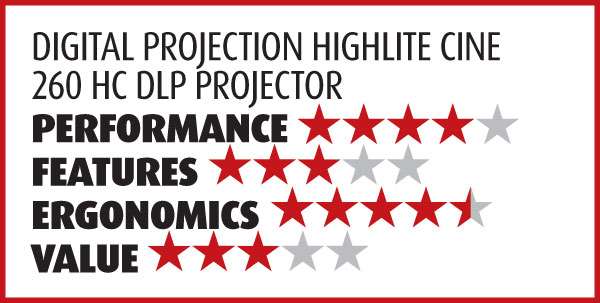Digital Projection HIGHlite Cine 260 HC DLP Projector Page 3
Test patterns are all well and good, but in the end, it all comes down to the images produced on real program material. From the brightest to all but the darkest scenes, the Cine 260 HC produced a jaw-dropping picture. Contributing to this, of course, was its ability to fill such a large screen with no apparent shortage of either brightness or resolution. Every detail was on the screen to see.
Every lack of detail was there as well. Don’t expect to be wowed by this or any projector with standard-definition sources blown up to this size. Topsy-Turvy is a hilarious but also dramatic look at 19th-century operetta legends Gilbert and Sullivan. The DVD transfer was definitely watchable on the Cine 260 HC, but it was hardly effulgent. On a 10-foot-wide screen, I challenge anyone to argue that Blu-ray isn’t dramatically better than DVD. (At press time, Topsy-Turvy wasn’t on Blu-ray, but it should be shortly.)

On a screen of this size, this projector clearly deserves the best program material you can give it. That means HD, both from Bluray and broadcast/cable/satellite. If you feed it such sources, the result is glorious. The color and detail on Baraka, one of the best Blu-ray transfers available (with spectacular 24-bit/96-kilohertz audio as well) will blow you away. I had a hard time being critical as I watched it, and it was a struggle to pull myself away long enough to take notes. OK, the projector’s blacks aren’t great (more on this below), but there are few scenes in Baraka that are dark enough to challenge this projector in that regard.
Unstoppable is a more typical transfer—it’s not overly wow-inducing, but it’s perfectly enjoyable. Like many modern films, the look is warm toned, slightly grungy, and overly contrasty. To correct for the latter, I preferred a slightly lighter gamma here (Film, rather than my Video preference for most material). I saw this film twice in the theater, once on film at one of the best venues in the country (the ArcLight in Hollywood) and again in a good local multiplex with digital projection. Visual memory is a sometimes thing, but in no respect apart from sheer size did the Cine 260 HC take a backseat to either theatrical presentation.
Inception looked terrific as long as the scenes didn’t go near dark. But when they did—for example, in the night scenes in chapter one as Cobb snakes through Saito’s darkened house—things turned more than a bit foggy. This is common in displays with less than the best black level.
And that’s the Cine 260 HC’s Achilles’ heel. The measured black level simply isn’t up to (or should I say down to) the level of the best home theater projectors, particularly LCOS and LCD displays from the likes of JVC, Sony, and Epson. Even the best single-chip DLPs can do better.
But that’s the nature of most three-chip DLP projectors. They are exceptionally bright, but that brightness comes at the cost of less than pristine blacks in the darkest scenes. As noted, the projector’s Dynamic Black mode drops the black level dramatically but comes with too many negatives to recommend it. We haven’t tested many three-chip DLP displays, but we’ve seen plenty, and the Cine 260 HC’s black level and shadow detail appear to be neither better nor worse than average among its ilk.
In defense of the Cine 260 HC, Digital Projection noted that it’s designed for use on much larger screens than what we used here and in higher ambient light. In those conditions, its extra brightness would win out and presumably aid the perception of deeper blacks and greater contrast, though such an installation is probably not the average or ideal home theater.
Still, in my setup and on anything beyond the most demanding dark scenes, the Cine 260 HC’s brightness and other fine attributes continued to floor me. Avatar looked stunning. I’ve never seen it look better, and that includes 3D IMAX. This projector is strictly 2D, but the images in this film are capable of remarkable depth even without 3D, and the Cine 260 HC got it all. Even the night scenes (which aren’t super dark) jumped off the screen, particularly the scene where Jake’s avatar gets left in the forest at night.
Yes, both the Sony and JVC projectors reviewed in this issue can do such scenes better. While I didn’t get the opportunity to directly compare these less expensive projectors directly to the Cine 260 HC on this big screen, I can say for certain that they wouldn’t be as bright, and I doubt if their resolution would hold up quite as well. The bigger the screen, the easier it usually is to spot the compromises that are inevitable in making a projector more affordable.
Conclusions
Some of the features of the Digital Projection HIGHlite Cine 260 HC weren’t as useful as they might have been, particularly Dynamic Black. The projector is also no world-beater in its black level and shadow detail on the darkest movie scenes. And you could argue that the absence of 3D compatibility in any home theater projector today needs to be seriously considered before purchase.
But the Digital Projection HIGHlite Cine 260 HC’s strengths—brightness, resolution, color, and an off-the-charts wow factor—are so good that it would be churlish to give it anything less than a strong recommendation and a Top Pick. Be advised that if you are content with (or can only accommodate) a smaller screen, want 3D, and/or are a stickler for the deepest blacks (like many of us here at Home Theater), there are other less expensive and very impressive options. But none of them will provide the big-screen experience in quite the same way.
























































